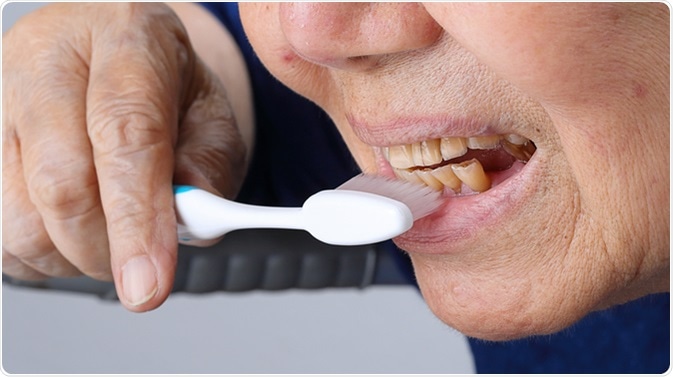Tooth or dental erosion is a progressive and irreversible loss of the outermost hard layer of the tooth structure. It is primarily caused by a chemical process and does not include bacterial involvement. Tooth erosion not only affects the aesthetic appearance of teeth but also results in dental complications such as tooth hypersensitivity and gradual erosion of the affected teeth.

Tooth structure is composed of various layers. Enamel being the hardest and outermost layer of the tooth structure. Enamel is made of carbonated calcium hydroxyapatite. Enamel has a pH of around 5.5, which is usually balanced by the saliva of the oral cavity. The prime role of saliva is to neutralize the acids and helps in maintenance of the right amount of pH in the oral cavity.
Soon after the consumption of food or drinks the pH of the oral cavity drops, which makes the enamel thin and soft for a shorter period leading to the loss of its mineral content. Saliva plays a critical role during this time and reverses the loss of mineral content of enamel by the process of remineralization and pH neutralization. In situations where there is a frequent attack of acids in the oral cavity, the pH of saliva becomes too acidic and enamel fails to recover the lost mineral content, hence resulting in gradual and eventually permanent loss which is referred to as dental erosion.
Signs of Tooth Erosion
There are a wide range of signs that are associated with tooth erosion, which usually depends upon the stage of the erosion. However, some of the common signs are:
- A painful sensation on consumption of sweets or hot and cold beverages and foods. This sign is usually present at an early stage of tooth erosion.
- Yellowish appearance of teeth, which results due to the exposure of the dentin
- Teeth become irregular, cracked or chipped
- Appearance of grooves on the tooth surface
An eroded tooth becomes more prone to dental caries and as caries progresses; it sinks to the deeper parts of the tooth. Once, the caries reaches to the nerve of the tooth, the sensations become extremely painful. Deep caries can further lead to complications such as abscess (pus formation) and tooth decay.
Causes of Tooth Erosion
Tooth erosion results in the dissolution of the mineralized tooth structure which occurs due to the contact with the acids introduced into the mouth. There are many causes through which acids are introduced in the oral cavity; however, the causes of dental erosion are broadly classified into extrinsic and intrinsic causes as discussed below:
Extrinsic Causes
Erosion of tooth structure due to extrinsic causes is primarily due to the introduction of acids via external sources. The prime reasons for extrinsic causes are due to eating habits, lifestyle or occupational factors that gradually sweep off the outermost part of the tooth due to high acid exposure. Some of the extrinsic sources responsible for dental erosion are:
- Beverages with low pH value: Drinks such as cold drinks and fruit juices usually have a low pH value which ranges from 2.0-3.5. Frequent consumption of these drinks induces high acids and makes teeth more prone to acid attack. According to research natural fruit juices, carbonated soft drinks and acidic foods have been found to increase the risk of dental erosion
- Certain Lifestyles: A frequent intake of acidic fruits and drinks is another major cause of dental erosion. For example, athletes performing extreme physical activities, frequently consume sports drink, which in turn increases the chances of erosion. Also, a decreased salivary flow and dehydration are other contributory factors for erosion.
- Occupational Hazards-Many occupations also pose a risk of dental erosion. Workers who work in factories, particularly in munitions, battery, and fertilizer plants are prone to dental erosion. Also, erosion has been reported in swimmers who remain in chlorinated water for long hours. Chlorinated water also has a lowered pH leading to gradual erosion of dental structure.
- Consumption of certain Medicines-Medicines that are acidic in nature also causes dental erosion. A direct contact of these medicines or chewing them for a longer period might lead to erosion of enamel. Some examples are medicines having high Vitamin C content and medicines with hydrochloric acid preparations.
Intrinsic Causes
Intrinsic causes of dental erosion results when the source of acid is inside the body and affects the tooth structure. Many medical conditions are responsible for causing intrinsic stains. Below is the list of conditions which can cause the reflux of acids in the oral cavity and can lead to erosion of teeth.
Gastroesophageal Reflux Disease (GERD)
During GERD disease, ejection of acids occurs which are mainly produced in stomach. A regular regurgitation is a normal procedure post consumption of meals, which usually occurs for about one hour during day time. However, in people affected with GERD gastric, acids are regurgitated in the oral cavity even during the night. This mostly affects the posterior teeth and a regular flow of acids washes away the outer layer of the tooth. Also, teeth are not naturally protected by saliva primarily because salivation and swallowing get restricted in the supine position.
Other conditions which increase the intra-abdominal pressure are pregnancy and obesity which also increase the acid reflux in the mouth.
Bulimia
Bulimia nervosa is an eating disorder in which a person performs a self-induced vomiting after consumption of meals. This disorder primarily exists in females who aim to maintain a desired weight. There is a typical loss of enamel on the lingual-palatal aspect of the anterior maxillary teeth, primarily due to the ejection of acids on the front teeth due to self-induced vomiting.
Excessive Alcohol Consumption
Alcoholism can lead to frequent episodes of vomiting, thereby leading to excessive reflux of acids from the stomach. Dental erosion is also exaggerated in alcoholics who consume highly acidic drinks. One research revealed that dental erosion was observed in 92 percent out of 37 patients who were alcoholics.
Sources
- https://www.ada.org/en/member-center/oral-health-topics/dental-erosion
- https://www.ncbi.nlm.nih.gov/pmc/articles/PMC4655683/
- https://www.dentalhealth.org/dental-erosion
- www.betterhealth.vic.gov.au/…/dental-erosion
Further Reading
- All Dental Erosion Content
- All Teeth Content
- Dental Health in Children
- Foods Good for Teeth
- Tooth Polishing Procedure
Last Updated: Oct 24, 2018

Written by
Akshima Sahi
Akshima is a registered dentist and seasoned medical writer from Dharamshala, India. Akshima is actively involved in educating people about the importance of good dental health. She examines patients and lends free counseling sessions. Taking her passion for medical writing ahead, her aim is to educate the masses about the value of good oral health.
Source: Read Full Article
